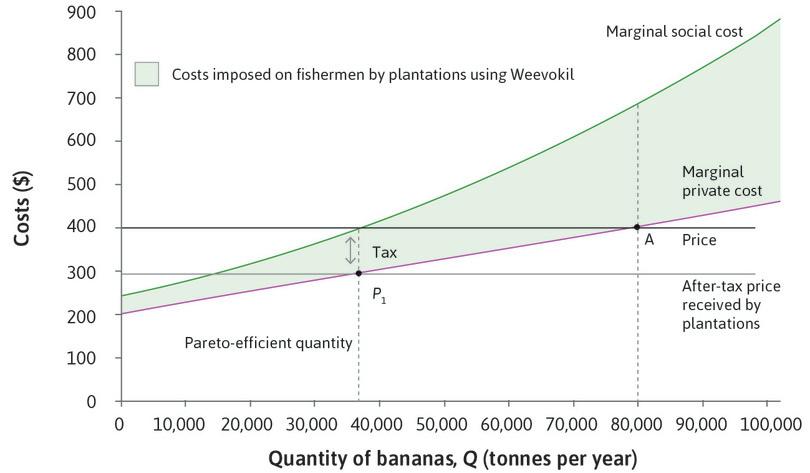Leibniz
12.3.1 Pigouvian taxes
A Pigouvian tax may be used by the government to address the problem of market failure due to an externality such as pollution. In this Leibniz, we show mathematically how to find the Pigouvian tax that achieves Pareto efficiency in our model of banana production using a polluting pesticide.
In our analysis of the external effects of Weevokil pollution (Leibniz 12.1.1), we show that the profit-maximizing banana plantations choose their output so that their marginal private cost is equal to the market price:
But the social surplus is maximized at the level of output at which the marginal social cost of bananas is equal to the price:
is the Pareto-efficient level of output. Remember also that the social cost can be written as the sum of the private cost and the external cost imposed on the fishermen by Weevokil pollution. So we can write the equation for the Pareto efficient output as:
Now suppose that the government imposes a tax of units of money for each tonne of bananas produced. The plantations’ cost of producing tonnes of bananas is now . Differentiating with respect to , we see that the marginal cost incurred by the plantations is : taxes raise the marginal cost of production. As before, plantations choose their output so that the marginal cost is equal to the price, but since the marginal cost has changed, so does their choice of output. They will produce , where:
Since the private marginal cost is an increasing function of , is smaller than if is positive—and the higher the tax, the lower the output produced.
Comparing this equation with the previous one, we can see how the government can achieve Pareto efficiency. If the tax is equal to , then the equation that determines is satisfied when . So by choosing a tax rate
the government can induce the plantations to choose the Pareto-efficient level of output . is called the Pigouvian tax rate.
The Pigouvian tax rate is the marginal external cost (MEC) at the Pareto-efficient output level. It addresses the externality problem and achieves Pareto efficiency by changing the marginal costs faced by the banana plantation owners so that they take into account the full social costs of their decisions, including the costs they impose on others.
An alternative way of thinking about the Pigouvian tax is to say that it works by changing the price that the plantations obtain for their bananas, rather than their costs. Then they will choose their output so that their marginal private cost is equal to the after-tax price . So again they choose , because:
This is illustrated in Figure 12.5 of the text, reproduced as Figure 1 below. The Pareto-efficient output of bananas is 38,000 tonnes, where the marginal social cost is equal to the price ($400). The tax is equal to the difference between the marginal social cost and the marginal private cost at this level of output, which is $100. The after-tax price, , is $300, and they choose an output of 38,000 tonnes because that is where the marginal private cost is equal to $300.
Finally, remember that we found the Pareto-efficient quantity of bananas by looking for the quantity that maximized the social surplus. We calculated the social surplus as the producer surplus minus the costs incurred by the fishermen. You may have noticed that the tax reduces the surplus of the fishermen, and wondered whether this changes the Pareto efficient quantity. The answer is that it does not do so, because with a tax on each tonne of bananas, the social surplus at quantity is:
The first term, in square brackets, is the producer surplus, taking into account the tax producers have to pay, and the second is the costs borne by the fishermen. The third term is the tax revenue obtained by the government which, provided that the tax revenue is used to benefit society, also contributes to the social surplus. But the two terms cancel each other out. Thus the social surplus is unaffected by the tax, and the Pareto-efficient output level remains the same, whether or not a tax is imposed.

